
Priestfield House was a Victorian Country House near Cults, Fife, Scotland.

Priestfield House was a Victorian Country House near Cults, Fife, Scotland.
The estate, originally an outlying property of Crawford Priory, was purchased from the Earl of Glasgow by a wealthy merchant, James Martin Esq. in 1889. [1] In 1892, he aggrandized the existing house by the addition of a substantial East Wing, comprising a first floor Billiards Room, a conical tower and a large Dining Room. In addition to this, the existing Service Wing was expanded to accommodate a larger domestic staff. The architect for the work was James Ross Gillespie of Gillespie & Scott of Queen Street, St Andrews. [2] The same architect was responsible for the construction of the extensive Priestfield Maltings nearby. [3]
The House was demolished in c.1968, owing partially to the decay of the East Wing. The Wash House, a fragment of the original service wing, survives.

James Martin (1841-1898), a merchant, bought the Priestfield Estate, initially comprising the farms of Priestfield, Pitlessie Mill and Brotus, as well as the superiority of the village of Pitlessie. Martin was an agriculturalist and industrialist, with extensive interests in malting, and the mining and burning of lime. At his death, his Cults lime works were said to be the largest of their kind in Scotland. [4] He died childless, and the estate passed to his niece, Mary Martin Smith Martin (1875-1909). The House was subsequently inherited by her brother, James Martin Smith JP, Laird of Priestfield (1876-1933), who assumed the additional surname of Martin. He married Marion Martin Smith (née Ainslie), of the families of Ainslie of Dolphinton and Hunter of Polmood.

St Monans, sometimes spelt St Monance, is a village and parish in the East Neuk of Fife and is named after the legendary Saint Monan.
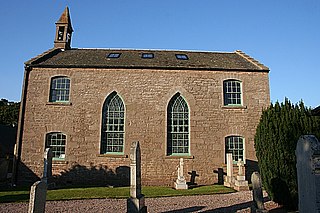
Kinnettles is located in Angus, a Council Area in the northeast of Scotland. The Parish is bounded on the north and east by Forfar, on the southeast and south by Inverarity and the southwest and northwest by Glamis. The centre of the Parish is dominated by the oblong Brigton Hill (164m) whose steepest slopes descend to the Kerbet Water. The Kerbet valley is well wooded and contains two small hamlets, Kirkton and Douglastown. The only other sizeable group of dwellings is at Ingliston on the flatter area to the northwest of the A94 Forfar to Glamis road. The northern boundary is the "Great Drain", now known as the Dean Water. Strathmore Estates constructed this, from Forfar Loch to the Kerbet, in the 18th century and thus helped to drain this previously boggy area. In addition it provided a transportation route for marl from the Loch to the Estate.

The Grange is an affluent suburb of Edinburgh, just south of the city centre, with Morningside and Greenhill to the west, Newington to the east, The Meadows park and Marchmont to the north, and Blackford Hill to the south. It is a conservation area characterised by large early Victorian stone-built villas and mansions, often with very large gardens. The Grange was built mainly between 1830 and 1890, and the area represented the idealisation of country living within an urban setting.

Springfield railway station serves the village of Springfield in Fife, Scotland. The station has two platforms and is unstaffed. Services are operated by ScotRail.

James Gillespie's High School is a state-funded secondary school in Marchmont, Edinburgh, Scotland. It is a comprehensive high school, educating pupils between the ages of 11 and 18, situated at the centre of Edinburgh. Edinburgh Castle and Holyrood Palace are within the catchment area of James Gillespie's High School.
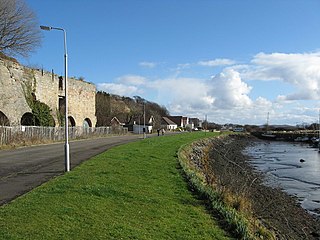
Charlestown is a village in Fife, Scotland. It lies on the north shore of the Firth of Forth, around 1 mile (1.6 km) west of Limekilns and 3 miles (5 km) south-west of Dunfermline.

Ross Priory is an early 19th-century country house located west of Gartocharn, West Dunbartonshire, on the south shore of Loch Lomond, Scotland. From the 14th century the estate, known as The Ross, was owned by a branch of the Buchanan family of Buchanan Castle, who built a house here in 1695. The present house is the result of remodelling by James Gillespie Graham and was complete in 1816. The term "priory" does not imply ecclesiastical provenance, but is simply a 19th-century romantic affectation. Sir Walter Scott spent time at Ross Priory in the years following the rebuilding. It was owned by subsequent members of the Leith-Buchanan family until the later 20th century. In 1973 it was sold to Strathclyde University and now serves as a recreational and conference centre.
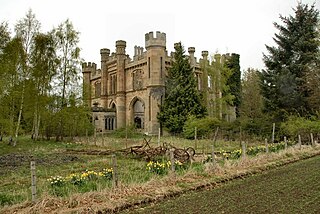
Crawford Priory is an estate house about 2 miles south west of Cupar, Fife, based on private land with no single owner. It is a former residence of the Earls of Crawford, Earls of Glasgow and Barons Cochrane of Cults. It lies just outside the village of Springfield.
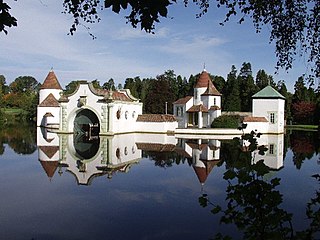
Craigtoun Country Park is a country park located approximately 4 miles to the south-west of St Andrews in the county of Fife, Scotland. The site is currently owned by Fife Council, with park amenities being operated as of 2012 by the charitable organisation Friends of Craigtoun Park.

John Lessels was a Scottish architect and artist, notably active in Edinburgh and also the Scottish Borders.

Prestonfield House is a boutique hotel in Prestonfield, Edinburgh, Scotland.

Cults is a small parish and hamlet close to the centre of the Kingdom of Fife, Scotland. It lies mainly in the Howe of Fife, and about 4+1⁄2 miles (7.2 km) south-west of the nearest town - Cupar. The parish is about 2+1⁄3 miles (3.8 km) long and 1+1⁄3 miles (2.1 km) wide.
Events from the year 1816 in Scotland.
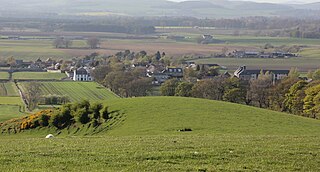
Pitlessie is a small village in Cults, Fife, Scotland. It is roughly 4+1⁄2 miles (7 km) southwest of the nearest large town, Cupar, and 23 miles north of Edinburgh. It had an estimated population of 325 in 2010.
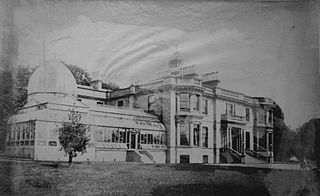
Balruddery House by Longforgan in Perthshire, Scotland, was designed by David Neave for James Webster circa 1820. In about 1879 it was bought by James F White, who had previously leased Castle Huntly in Longforgan. James White and his son J Martin White had the house extensively remodelled and modernised by Charle Edward and Thomas Saunders Robertson and the White family moved in circa 1881. J Martin White was very interested in the technologies of the day and electricity was installed in the house by April 1881, powered by a generator run off a stream on the estate, possibly the first domestic generating plant in Scotland. Until at least 1960, electricity was still provided by a turbine and generator on the Mill Dam at Balruddery Home Farm.
Ernest Arthur Oliphant Auldjo Jamieson FRIBA MID (1880–1937) was a Scottish architect operating in the early 20th century. He specialised in country houses, largely for wealthy family friends. From after the First World War he also got many commissions from local authorities for social housing, plus several commissions related to hospitals and asylums.

John Murray Robertson FRIBA was a 19th-century Scottish architect who did much to change Dundee.
Sir James Dick of Prestonfield (1644–1728) was a 17th/18th century Scottish merchant who served as Lord Provost of Edinburgh from 1679 to 1681. He was the first Baronet of Prestonfield and was progenitor to the Dick baronets.
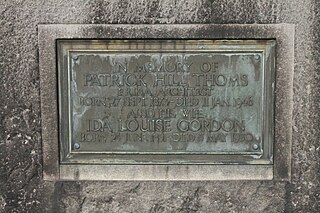
Patrick Hill Thoms FRIBA ARIAS (1873–1946) was a 20th-century Scottish architect, based in eastern Scotland.

David Forbes Smith (1865–1923) was a Scottish architect of many of the Edwardian Baroque civic and co-operative buildings in Fife during the late nineteenth and early twentieth century. Born in Kirkcaldy in 1865 he apprenticed as a carpenter before being articled to John Murray of Kirkcaldy as an architect from 1885 to 1888. He obtained a place in the newly formed partnership of Honeyman & Keppie in Glasgow, overlapping and being photographed in staff pictures with Charles Rennie Mackintosh, and was briefly in the office of Charles Davidson of Paisley before moving to Salisbury as chief assistant to the architect Fred Bath whose office he passed the qualifying exam in 1893. He was admitted as an Associate of the Royal Institute of British Architects on 12 March 1894. In 1898 he returned to his home town, spending the remainder of his career running his own practice until his death on 28 October 1923.